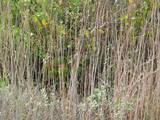Weaver news
| Friedl TWP, Groscurth E. 2012. A real-time PCR protocol for simple and fast quantification of blood parasite infections in evolutionary and ecological studies and some data on intensities of blood parasite infections in a subtropical weaverbird. Journal of Ornithology 153:239-247. Abstract. "In several fields of research, such as immunoecology, evolutionary ecology, sexual selection, parasitology or host-parasite coevolution, a reliable quantitative assessment of blood parasite infections is necessary for testing specific predictions regarding relationships between the degree of infections and various parameters of interest. Here, we present a relatively simple, fast and reliable protocol based on quantitative real-time PCR to determine the intensity of infections with blood parasites of the genus Plasmodium and/or Haemoproteus in blood samples of birds, using male Red Bishops (Euplectes orix; Ploceidae, Passeriformes) as example. The intensity of infections is assessed by amplification of a specific 85-bp fragment within the plastid-like large subunit ribosomal-RNA (LSU-rRNA) gene, which is conservative across a range of Plasmodium and Haemoproteus species. By measuring the accumulation of the product during the PCR (in real-time) using a fluorescent labelled oligonucleotide probe, a threshold can be determined at which the fluorescence of the product raises above background level. The starting quantity of blood parasites in the investigated blood samples is then calculated by comparison with thresholds determined for standards of known quantity (clones of a 594-bp fragment within the LSU-rRNA gene from Plasmodium falciparum including the target sequence) in the same PCR reaction. With this method, blood parasites were detected in 123 out of 127 samples from male Red Bishops, with a median of 0.059 blood parasites per 100 blood cells (range 0-19.2 blood parasites per 100 blood cells). The method described here produces consistent and reproducible data, can easily be modified and extended to detect and quantify blood parasites at different systematic levels, and thus has broad application to many researchers in the field of evolutionary and behavioral ecology."
This is the most recent paper from the a long-term research on sexual selection, reproductive biology and life-history evolution of Southern Red Bishops at Addo Elephant National Park, Eastern Cape Province. To read more about his research, and see a publication list, see Thomas Friedl. Previous reviews of Friedl's research may be read: 2010a, 2010b and 2011. Literature as featured in Weaver Watch news items |










